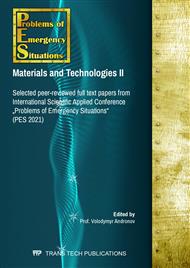[1]
Jiang-hua Zhan, GabLai-jun Zhao, Risk Analysis of Dangerous Chemicals Transportation, Systems Engineering – Theory & Practice, 27 (2007) 117–122.
DOI: 10.1016/s1874-8651(08)60077-0
Google Scholar
[2]
P.I. Kawamura, D. Mackay, The evaporation of volatile liquids, Journal of Hazardous Materials, 15 (1987) 343–364.
DOI: 10.1016/0304-3894(87)85034-3
Google Scholar
[3]
Fire extinguishing media – Foam concentrates – Part 3: Specification for low expansion foam concentrates for surface application to water-immiscible liquids, European standard (2018).
DOI: 10.3403/30302165
Google Scholar
[4]
G.N. Kuprin, D.S. Kuprin, Fast-Hardening Foam: Fire and Explosion Prevention at Facilities with Hazardous Chemicals, Journal of Materials Science Research. 4 (2017) 56–61.
DOI: 10.5539/jmsr.v6n4p56
Google Scholar
[5]
J. Roller, A. Laganapan, J.-M. Meijer, M. Fuchs, An. Zumbusch, Observation of liquid glass in suspensions of ellipsoidal colloids, Proceedings of the National Academy of Sciences of the United States of America, PNAS, 118 (3) (2021).
DOI: 10.1073/pnas.2018072118
Google Scholar
[6]
Yu.A. Abramov, A.A. Kireev, Geleobrazuyushchiye ognetushashchiye i ognezashchitnyye sredstva povyshennoy effektivnosti primenitel'no k pozharam klassa A, NUGZU, (2015) 254 [in Russian].
Google Scholar
[7]
R. Pietukhov, A. Kireev, E. Slepuzhnikov, M. Chyrkina, A. Savchenko, Lifetime research of rapid-hardening foams, Problems of emergency situations. 31 (2020) 226–233.
DOI: 10.52363/2524-0226-2021-33-7
Google Scholar
[8]
Hazard Classification Guidance for Manufacturers, Importers, and Employers, Occupational Safety and Health Administration U.S. Department of Labor, OSHA, 3844 (2) (2016) 406–419.
Google Scholar
[9]
R.A. Petukhov, A.A. Kireev and V.V. Deineka. Pidvyshchennya chasu isnuvannya pin shvydkoho tverdnennya, Problems of emergency situations, 32 (2020) 215–222 [in Ukrainian].
Google Scholar
[10]
I.F. Dadashov, D.G. Tregubov, Yu.M. and О.О. Kireev. Napryamky vdoskonalennya hasinnya pozhezh naftoproduktiv, Naukovyy visnyk budivnytstva. 94 (4) (2018) 238-249 [in Ukrainian].
Google Scholar
[11]
І. Dadashov, А. Kireev. I. Kirichenko, A. Kovalev, A. Sharshanov, Simulation of the properties two-laer material, Functional Materials, 25 (4) (2018) 774–779.
Google Scholar
[12]
A.Chernukha, A.Teslenko, P Kovaliov., O. Bezuglov, Mathematical Modeling of Fire-Proof Efficiency of Coatings Based on Silicate Composition, Materials Science Forum. 1006 (2020) 70–75.
DOI: 10.4028/www.scientific.net/msf.1006.70
Google Scholar
[13]
A. Kireev, D. Tregubov, S. Safronov, D. Saveliev, Study Insulating and Cooling Properties of the Material on the Basis of Crushed Foam Glass and Determination of its Extinguishing Characteristics with the Attitude to Alcohols, Materials Science Forum, 1006 (2020) 62–69.
DOI: 10.4028/www.scientific.net/msf.1006.62
Google Scholar


